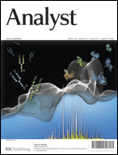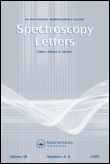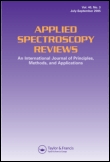
SPECTROCHIMICA ACTA PART B-ATOMIC SPECTROSCOPY
Scope & Guideline
Elevating Atomic Insights, One Spectrum at a Time.
Introduction
Aims and Scopes
- Laser-Induced Breakdown Spectroscopy (LIBS):
A significant focus area of the journal is LIBS, a technique used for rapid elemental analysis of various materials. The articles often explore advancements in LIBS technology, including improvements in signal sensitivity, spatial resolution, and applications to complex samples. - Inductively Coupled Plasma Mass Spectrometry (ICP-MS):
The journal regularly features research on ICP-MS, highlighting its applications in trace element analysis, isotopic analysis, and method development to enhance detection limits and accuracy. - X-ray Fluorescence (XRF) Techniques:
XRF methods are frequently discussed, with papers detailing novel approaches for quantifying elements in diverse matrices, including environmental samples, cultural heritage artifacts, and geological materials. - Machine Learning and Chemometrics:
The integration of machine learning and chemometric methods in spectroscopic analyses is an emerging theme, focusing on enhancing data interpretation, improving accuracy, and addressing matrix effects in various analytical techniques. - Environmental and Geological Applications:
Research addressing the application of spectroscopic methods to environmental monitoring and geological analysis is prevalent, demonstrating the journal's commitment to practical applications that impact sustainability and resource management. - Biomedical Applications:
The journal also explores the use of atomic spectroscopy in biomedical contexts, emphasizing the analysis of biological samples for health diagnostics and monitoring.
Trending and Emerging
- Multi-Element and Multi-Technique Approaches:
There is a marked increase in studies employing multi-element analysis techniques that combine various spectroscopic methods. This trend highlights the need for comprehensive analytical solutions that address complex sample matrices. - Environmental Monitoring and Sustainability:
Recent publications emphasize the application of atomic spectroscopy in environmental monitoring, particularly regarding pollution detection and resource management, aligning with global sustainability goals. - Machine Learning Integration:
The incorporation of machine learning techniques into spectroscopic analysis is rapidly growing. This trend indicates a shift towards data-driven methodologies that enhance the accuracy and efficiency of analytical results. - Advanced Plasma and Laser Techniques:
Research on innovative laser and plasma methodologies, such as high-repetition-rate LIBS and novel plasma sources, is trending, showcasing the journal's commitment to cutting-edge technology in atomic spectroscopy. - Cultural Heritage and Forensic Applications:
Emerging interest in the application of atomic spectroscopy techniques for the analysis of cultural heritage artifacts and forensic investigations is evident, indicating a broader societal relevance of the field.
Declining or Waning
- Traditional Atomic Absorption Spectrometry (AAS):
Although AAS remains a foundational technique in elemental analysis, its relative representation in the journal has declined as more advanced techniques like ICP-MS and LIBS gain traction. - Conventional Spectroscopy Without Advanced Data Analysis:
Papers focusing solely on conventional spectroscopy without the integration of advanced data analysis techniques, such as machine learning, are becoming less common, indicating a shift towards more sophisticated analytical approaches. - Basic Theoretical Studies:
Research centered on fundamental theoretical aspects of atomic spectroscopy, without direct application or methodological advancement, is less frequently published, suggesting a preference for practical applications and innovations. - Single-Element Focus Studies:
There has been a noticeable decrease in studies focusing on the analysis of single elements in isolation, as the journal increasingly favors multi-elemental analysis and comprehensive profiling of complex samples.
Similar Journals

ChemistryMethods
Advancing Practical Chemistry for a Brighter FutureChemistry Methods, published by WILEY, is an esteemed journal in the field of chemical sciences that serves as a vital platform for disseminating cutting-edge research and methodologies across various domains of chemistry. With a focus on practical approaches in areas such as fluid flow and transfer processes, spectroscopy, electrochemistry, and catalysis, this journal has achieved impressive ranks in Scopus—including a notable 15th position in both fluid flow and spectroscopy categories, which reflects its significant contribution to advancing the discipline. Although Chemistry Methods operates under a traditional access model, it remains crucial for researchers, professionals, and students who are eager to engage with high-quality original research and reviews. Since its inception in 2021, the journal's objective has been to bridge the gap between theoretical knowledge and practical application in chemistry, fostering innovation and collaboration within the global scientific community.

ARCHAEOMETRY
Advancing Archaeological Insights Through Innovative Research.ARCHAEOMETRY, published by WILEY, is a premier journal that has established itself at the forefront of research in the fields of archaeology and history since its inception in 1958. With an impressive Q1 ranking in both Archaeology and History for 2023, and notable Scopus rankings placing it in the top 98th percentile for History and the 91st percentile for Archaeology, this journal is an invaluable resource for researchers and professionals dedicated to advancing knowledge in these disciplines. The journal's comprehensive scope addresses a wide array of topics related to the materials and techniques used in archaeological investigation, fostering interdisciplinary dialogue and collaboration. Though not an open access publication, its impactful content is meticulously curated to promote scholarly excellence and innovation. By bridging the gap between science and the humanities, ARCHAEOMETRY plays a crucial role in unraveling the complexities of human pasts, making it an essential addition to the libraries of scholars and students alike.

Mass Spectrometry Letters
Fostering Innovation in the Heart of Mass Spectrometry.Mass Spectrometry Letters is a pioneering open-access journal published by the Korean Society for Mass Spectrometry, specializing in the diverse fields of analytical chemistry, biochemistry, and spectroscopy. Established in 2010, this journal aims to disseminate groundbreaking research and advancements in mass spectrometry and its applications across various scientific domains. Though currently categorized in the Q4 quartile in key analytical fields, Mass Spectrometry Letters serves as an essential platform for researchers, professionals, and students to share innovative methodologies, emerging trends, and practical applications of mass spectrometry, thus fostering collaboration and advancing knowledge in the scientific community. With a commitment to open access, articles published since 2010 are readily available, enabling widespread distribution and engagement within the international research community. Located in Daejeon, South Korea, and actively converging research through 2024, the journal holds the potential to grow its impact and relevance within the dynamic landscape of mass spectrometry.

INTERNATIONAL JOURNAL OF MASS SPECTROMETRY
Exploring Innovations in Analytical ChemistryINTERNATIONAL JOURNAL OF MASS SPECTROMETRY, published by Elsevier, is a pivotal platform in the field of mass spectrometry, advancing the understanding and application of this essential analytical technique. With an ISSN of 1387-3806 and an E-ISSN of 1873-2798, the journal has established its significance since its inception in 1998 and continues to contribute valuable insights to the scientific community through its convergence of knowledge extending to 2024. Its scope encompasses critical areas such as condensed matter physics, instrumentation, physical and theoretical chemistry, and spectroscopy, earning recognition across various ranks and quartiles, specifically holding a Q3 classification in multiple categories for 2023. Although it does not currently operate under an open access model, the journal remains an essential resource for researchers, professionals, and students striving to deepen their expertise and stay abreast of the latest methodological developments and discoveries in mass spectrometry. With its commitment to quality and innovation, the INTERNATIONAL JOURNAL OF MASS SPECTROMETRY plays a crucial role in supporting advancements in analytical chemistry and instrumental analysis.

Molbank
Connecting Scholars through Molecular DiscoveriesMolbank is an open-access journal published by MDPI, dedicated to the fields of Biochemistry, Organic Chemistry, and Physical and Theoretical Chemistry. Established in 2002, this journal has served as a vital platform for the dissemination of research findings, where researchers and professionals share original articles focusing on molecular chemistry, synthesis, and related studies. With a commitment to open access, Molbank enables global access to scientific knowledge, fostering collaboration and innovation among scientists. While currently categorized in the fourth quartile for its field rankings, it provides a unique opportunity for emerging scholars to contribute to and engage with the scientific community. The journal is based in Switzerland, operating from its office at ST ALBAN-ANLAGE 66, CH-4052 BASEL, SWITZERLAND, and continues to attract submissions until 2024. Researchers, students, and professionals looking to expand their knowledge and participate in the dialogue of current molecular chemistry can benefit significantly from engaging with the content published in Molbank.

Journal of Spectroscopy
Elevating Spectroscopy: Where Knowledge Meets InnovationJournal of Spectroscopy, published by HINDAWI LTD since 2009, is a renowned Open Access journal based in Egypt that serves as a valuable platform for the dissemination of cutting-edge research in the fields of analytical chemistry, atomic and molecular physics, and optics. With the unique ISSN 2314-4920 and E-ISSN 2314-4939, this journal aims to facilitate collaboration and knowledge exchange among researchers, professionals, and students by providing unrestricted access to essential findings and advancements. As of 2023, it holds a Q3 ranking in both Analytical Chemistry and Atomic and Molecular Physics, and a Q4 ranking in Spectroscopy, indicating its growing influence and relevance within the academic community. The journal also maintains a Scopus rank of #126 in Atomic and Molecular Physics and #53 in Spectroscopy, showcasing its commitment to high-quality scholarly content. With a converged timeline from 2013 to 2024, the Journal of Spectroscopy is positioned as a pivotal resource for the latest discoveries and innovative applications in spectroscopy-related studies.

RAPID COMMUNICATIONS IN MASS SPECTROMETRY
Elevating standards in analytical and organic chemistry.RAPID COMMUNICATIONS IN MASS SPECTROMETRY is a leading journal published by Wiley, focusing on the rapidly evolving field of mass spectrometry and its applications across various domains, including analytical, organic, and spectroscopy chemistry. With its ISSN 0951-4198 and an E-ISSN of 1097-0231, the journal has firmly established itself as a reputable source of innovative research since its inception in 1987, and is set to continue until 2024. As evidenced by its 2023 Scopus rankings, the journal occupies a solid position in the realms of analytical chemistry (Q3), organic chemistry (Q3), and spectroscopy (Q3), reflecting its impact among a diverse audience of researchers and professionals. Although it is not an open-access publication, the findings shared within its pages are pivotal for advancing knowledge and practical applications in mass spectrometry, making it an essential resource for students and experts aiming to stay abreast of the latest scientific developments.

ANALYST
Empowering Innovation in Chemistry and BeyondANALYST, published by the Royal Society of Chemistry, stands as a prestigious journal in the fields of Analytical Chemistry, Biochemistry, Electrochemistry, Environmental Chemistry, and Spectroscopy. Esteemed for its rigorous peer-review process and influential contributions to the advancement of scientific knowledge, the journal has been a vital resource for researchers and professionals since its inception in 1876. With an impressive Scopus ranking that places it in the top quartile for several chemical disciplines, it specifically ranks #12 in Spectroscopy and #31 in Analytical Chemistry, reflecting its robustness and relevance in the analytical sciences. Though currently not an Open Access publication, ANALYST provides valuable insights and cutting-edge research that help drive innovation and discovery in various scientific realms. Researchers and students alike will benefit from its commitment to disseminating high-quality research that addresses contemporary challenges and promotes interdisciplinary collaboration.

SPECTROSCOPY LETTERS
Unveiling Innovations in Spectroscopy Since 1968SPECTROSCOPY LETTERS, published by Taylor & Francis Inc, is a pivotal journal that plays a significant role in the fields of Analytical Chemistry, Atomic and Molecular Physics, and Optics. With an ISSN of 0038-7010 and E-ISSN of 1532-2289, it provides a platform for the dissemination of cutting-edge research and developments in spectroscopy and its wide-ranging applications. As of 2023, the journal is ranked in the third quartile (Q3) across its relevant categories, reflecting its importance in these scientific domains. The journal has a continuous publication history from 1968 to 2024, establishing a rich legacy in academic literature. Although it currently does not offer Open Access options, SPECTROSCOPY LETTERS remains a valuable resource for researchers, professionals, and students seeking to advance their knowledge and applications in spectroscopy. For those in the arena of physics and chemistry, this journal is essential for keeping abreast of the latest findings and methodologies in the field.

APPLIED SPECTROSCOPY REVIEWS
Transforming Research Through Spectroscopic InsightsAPPLIED SPECTROSCOPY REVIEWS, published by Taylor & Francis Inc, is a premier journal in the field of spectroscopy and instrumentation, housed in the United States. With an impressive 2023 impact factor reflecting its esteemed presence, this journal stands out in both the Physics and Astronomy (Rank #5/141, Percentile 96th) and Chemistry (Rank #6/76, Percentile 92nd) disciplines. Spanning over five decades since its inception in 1967, the journal has made significant contributions to the understanding of spectroscopy applications across a wide array of scientific fields. With a focus on publishing high-quality reviews that summarize and synthesize advances in the field, APPLIED SPECTROSCOPY REVIEWS aims to serve as a vital resource for researchers, professionals, and students alike. This journal, classified in the top quartile (Q1) for both its categories in 2023, underscores its integral role in advancing knowledge and innovation in the spectroscopy community. Though not open access, it remains an essential read for those seeking comprehensive insights and developments within the realm of applied spectroscopy.